| Article ID | Journal | Published Year | Pages | File Type |
|---|---|---|---|---|
| 4373156 | Ecological Indicators | 2014 | 8 Pages |
•United State management policy for marine mammals is to maintain populations at an optimal sustainable population (OSP) level.•Information to determine OSP is lacking so an index is needed.•Calf:cow ratios from harvest data meet the requirements of a robust index of OSP for the Pacific walrus (Odobenus rosmarus divergens) population.•Changes in harvest effort and efficiency due to changes in sea ice dynamics as a result of a warming climate will require ongoing evaluation of the index.
The United States Marine Mammal Protection Act of 1972 (MMPA) specified that marine mammal stocks be maintained at an optimum sustainable population level (OSP). However, the information needed to directly estimate OSP for most stocks was not available and indices to OSP were soon proposed but to our knowledge none were fully developed. In 1994, a new management regime was adopted under the MMPA, potential biological removal (PBR), which was specifically developed to assess marine mammal mortalities associated with commercial fisheries. Pacific walruses (Odobenus rosmarus divergens) are rarely killed in commercial fisheries, the greatest source of human caused mortality is the subsistence harvest by Alaskan and Russian natives, and PBR estimates have been erroneously used to make inference about the sustainability of the subsistence harvest. It is clear that an index to OSP is needed for the Pacific walrus because PBR as calculated for fisheries is not appropriate. In this study, we explored calf:cow ratios (CCR), estimated from spring harvest data, as an index to population abundance and OSP as a function of habitat carrying capacity (K). Eight of the 10 characteristics of an effective index are applicable to CCRs. Based on abundance estimates when the Pacific walrus population was at or near K and a simulated estimate of maximum net productivity, CCRs of 0.41–0.47 reflect a Pacific walrus population at OSP. The best use of the CCR index will be to inform subsistence hunters of the status of the population and to promote self-regulation of the harvest by hunters. However, because other factors which may be weakly density-dependent such as disease and physical trauma could effect CCRs and the same CCR can be expressed by a declining or increasing population, the index will need to be combined with other information (e.g., habitat change and use patterns, population trend, physical condition of individuals, survival rates, etc.) in a weight of evidence approach in order to have stronger inference. Furthermore, our analyses are based on a data set that included periods when climatic conditions differed from those of recent decades, requiring evaluation of the index into the future.
